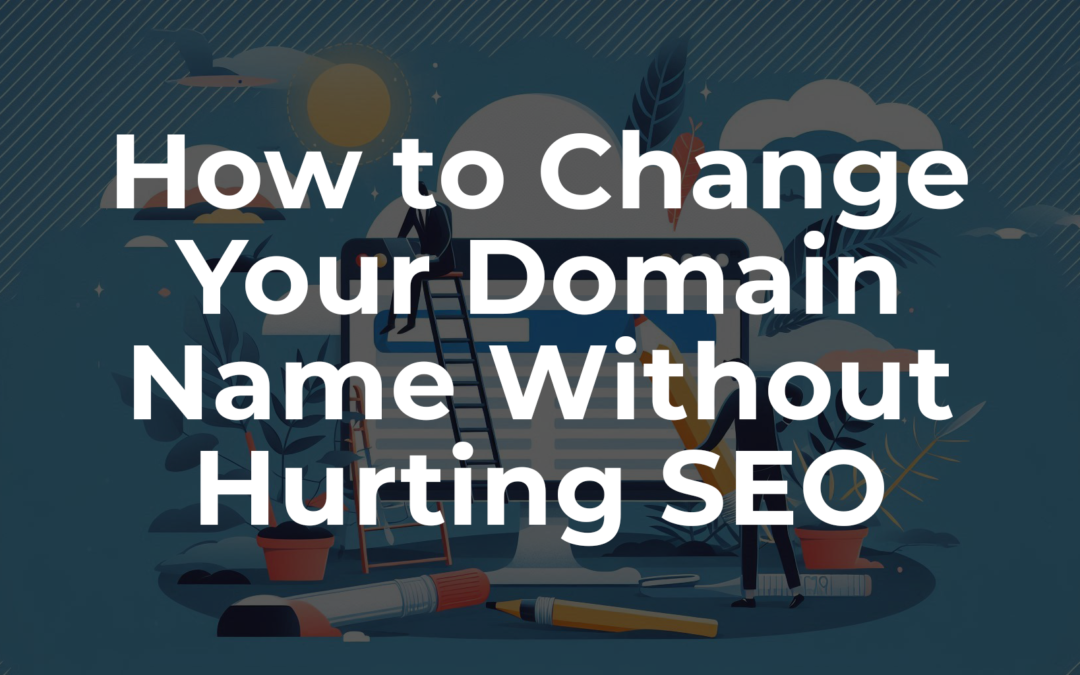
General
Changing your domain name can feel like navigating a minefield for SEO. A single misstep could tank your rankings, erase hard-earned traffic, and disrupt your online presence. But with the right strategy, you can transition smoothly while preserving (or even boosting) your SEO performance. This guide walks you through the process step-by-step, shares best practices, and answers critical questions to ensure your domain migration succeeds.
Why Change Your Domain Name?
Before diving into the how, let’s address the why. Common reasons to change your domain include:
- Rebranding: Aligning your domain with a new brand identity.
- Better Name: Switching to a shorter, memorable, or keyword-rich domain.
- Merging Websites: Consolidating multiple sites into one.
- Targeting New Markets: Using a country-specific TLD (e.g., .uk, .ca).
- Escaping Penalties: Moving away from a domain flagged by Google for spam.
Whatever your reason, proceed cautiously—domain changes require meticulous planning.
How to Change Domain Name: Quick Start
Follow these six steps to minimize SEO disruptions:
Step 1: Decide on the New Domain, and Buy It
- Choose a domain that’s brandable, easy to spell, and relevant to your niche.
- Avoid hyphens or numbers to prevent user confusion.
- Use tools like Ahrefs or SEMrush to check the domain’s history for penalties.
Step 2: Do a Full SEO Audit of Your Content
- Audit existing pages using tools like Screaming Frog.
- Fix broken links, optimize meta tags, and update outdated content.
- Note high-performing pages—these need extra care during migration.
Step 3: Back Up Your Current Website
- Save all files, databases, and content. Use plugins like UpdraftPlus (WordPress) or manually export your site.
Step 4: Create 301 Redirects Using .htaccess
Step 5: Tell Google You Moved
- Use Google Search Console’s Change of Address tool.
- Submit an updated sitemap for the new domain.
Step 6: Enjoy Your New Site!
- Monitor rankings and traffic closely for 3–6 months.
Changing Your Domain Name: Best Practices
- Educate Yourself on SEO & Domain Migration
- Hire an SEO Expert for Complex Migrations
- Experts handle technical issues like canonical tags, hreflang, or international SEO.
- Think Through URL Structure Changes
- Keep URLs consistent if possible (e.g.,
/blog/post-name remains the same).
- If Merging Sites, Clean Both First
- Remove duplicate content and fix broken links on both domains.
- Monitor Everything Post-Launch
- Track rankings, traffic, crawl errors, and indexation via Google Analytics and Search Console.
- Prepare for Months of Fluctuating Traffic
- Temporary dips are normal as Google re-indexes your site.
- Announce Your New Domain
- Update social profiles, email signatures, and run a “We’ve Moved” campaign.
- Update Other Web Properties
- Fix links in directories, guest posts, and partnerships.
- Double-Check 301 Redirects
- Broken redirects = lost SEO value.
Example of a Featured Snippet
Q: How long does it take for SEO to recover after a domain change?
A: Most sites see rankings stabilize within 2–4 months, assuming proper 301 redirects and minimal technical errors.
Questions on How to Change Your Domain Name?
Q: Will changing my domain name reset my SEO progress?
A: Not if done correctly. 301 redirects preserve link equity, and consistent content keeps rankings intact.
Q: Can I change my domain without losing backlinks?
A: Yes—implement 301 redirects to ensure old links point to the new domain.
Q: Do 301 redirects slow down my site?
A: Poorly configured redirects can. Avoid chains and keep redirects server-side.
Q: Should I keep my old domain live forever?
A: No, but leave redirects active for at least 12 months.
Key Takeaways
- Plan meticulously: Audit, back up, and map redirects before launching.
- Prioritize user experience: Ensure visitors (and search engines) land on the right pages.
- Monitor rigorously: Use tools to catch issues early.
By following this guide, you’ll protect your SEO equity and set your new domain up for long-term success. 🚀
Need help with your domain migration? Black Web Spider specializes in seamless, SEO-friendly transitions. Contact us today!
Related Topics:
- change domain name without losing SEO
- how to migrate domain name”, “SEO-friendly domain change”, “301 redirect best practices
- how to change domain name without affecting ranking”, “steps to change domain name safely

General, Web Design & Development
In the realm of website design and development, custom theme development stands out as a crucial aspect that allows websites to truly shine. Crafting unique WordPress themes requires a blend of creativity, technical expertise, and a deep understanding of user experience. This article delves into the art of creating bespoke WordPress themes that captivate audiences and elevate online presence.
The Essence of Custom Theme Development
When it comes to custom theme development, the goal is to design a website that not only reflects the brand identity but also offers a seamless user experience. By tailoring every aspect of the theme to suit specific needs, developers can create a unique WordPress theme that sets the website apart from the competition.
Key Elements of Custom Theme Development

1. Design Flexibility
One of the primary advantages of custom theme development is the ability to have complete control over the design. From color schemes to typography choices, every element can be customized to align with the brand’s aesthetics.
A well-crafted custom WordPress theme not only looks visually appealing but also ensures optimal performance. By eliminating unnecessary code and optimizing images, developers can enhance loading speeds and overall user experience.
3. Responsive Design
In today’s mobile-centric world, responsive design is non-negotiable. Custom themes are built with responsiveness in mind, ensuring that the website looks and functions flawlessly across all devices.
Steps to Creating a Unique WordPress Theme

1. Research and Planning
Before diving into development, thorough research on the target audience, competitors, and industry trends is essential. This information serves as a foundation for creating a custom WordPress theme that resonates with users.
2. Wireframing and Prototyping
Creating wireframes and prototypes allows developers to visualize the layout and functionality of the theme before diving into coding. This step helps in identifying potential issues early on and streamlining the development process.
3. Coding and Implementation
Using best practices in web development, such as clean code structure and proper documentation, developers bring the custom WordPress theme to life. Attention to detail is key during this phase to ensure a seamless end product.
4. Testing and Optimization
Thorough testing across various browsers and devices is crucial to identify any bugs or inconsistencies. Optimization techniques, such as minifying CSS and JavaScript files, further enhance performance.
Read article 5 Innovative Strategies for Enhancing User Experience on Your Website.
Benefits of Custom Theme Development
- Enhanced Brand Identity: A unique WordPress theme reinforces brand identity and sets the website apart from generic templates.
- Improved User Experience: Tailoring every aspect of the theme leads to a user-friendly interface that enhances engagement.
- Scalability: Custom themes are scalable and can adapt to evolving business needs without compromising performance.
Conclusion
In conclusion, custom theme development plays a pivotal role in creating unique WordPress themes that resonate with audiences and elevate online presence. By combining creativity with technical expertise, developers can craft bespoke themes that not only look visually stunning but also offer exceptional user experiences. Embrace the art of custom theme development to unlock endless possibilities for your website’s success!

General, Social Media
Introduction
In the fast-paced digital landscape, the success of a small business hinges on effective social media management. Recognizing the signs that your business needs a social media agency is crucial. This article delves into the key indicators, offering actionable insights to propel your business forward.
5 Signs Your Small Business Needs a Social Media Agency – An In-Depth Analysis
| Section | Subsection |
|---|
| Understanding the Social Media Landscape | What Sets the Social Media Scene Apart for Small Businesses? |
| The Role of LSI Keywords in Social Media Management |
| Signs Your Business is Falling Behind | Decreased Engagement Rates: A Red Flag |
| Lacking Consistent Brand Presence |
| Ignoring the Power of Visual Content |
| Competitors Surpassing Your Online Presence |
| The Impact on Brand Image and Reputation | Negative Reviews Amplified on Social Platforms |
| The Need for Proactive Crisis Management |
| Optimizing Social Media for Business | Leveraging Social Media Advertising |
| Crafting Shareable Content |
| Utilizing Analytics for Informed Decision-making |
| Engaging with the Audience |
| 5 Signs Your Small Business Needs a Social Media Agency | Inconsistent Posting Schedule |
| Stagnant Follower Growth |
| Unimpressive Social Media Metrics |
| Frustration Overkeeping Up with Algorithm Changes |
| Recognizing the Time-Consuming Nature of Social Media |
| FAQs: Unlocking Further Insights | What Benefits Can a Social Media Agency Provide? |
| How Can I Choose the Right Social Media Agency? |
| Is Social Media Advertising Worth the Investment? |
| What Results Can I Expect from Social Media Management? |
| How Does Crisis Management Work in the Social Media Space? |
| Can I Optimize Social Media on My Own? |
In the dynamic world of social media, small businesses face unique challenges. Recognizing the signs that your business requires professional social media management is crucial for sustained growth.
Understanding the Social Media Landscape
What Sets the Social Media Scene Apart for Small Businesses?
Small businesses often struggle to stand out in the vast social media landscape. Learn how LSI Keywords can be a game-changer in enhancing your business’s visibility.

LSI Keywords social media agency for small businesses
Signs Your Business is Falling Behind
Decreased Engagement Rates: A Red Flag
Discover the warning signs of diminishing engagement and why a social media agency is equipped to revitalize your online interactions.
Lacking Consistent Brand Presence
Consistency is key. Explore how a social media agency ensures your brand remains at the forefront of your audience’s minds.
Ignoring the Power of Visual Content
Visuals speak louder than words. Uncover the impact of neglecting visual elements in your social media strategy and how an agency can rectify this.

visual elements in social media strategy
Competitors Surpassing Your Online Presence
Stay ahead of the competition by understanding how a social media agency can help bridge the gap and propel your business forward.
The Impact on Brand Image and Reputation
Negative Reviews Amplified on Social Platforms
Addressing negative reviews promptly is vital. Learn how a social media agency can mitigate the impact of negative feedback on your brand.
The Need for Proactive Crisis Management
In the age of instant sharing, crises can escalate quickly. Discover why proactive crisis management is essential for preserving your brand’s reputation.
Optimizing Social Media for Business
Leveraging Social Media Advertising
Unlock the potential of targeted advertising on social media platforms and how it can revolutionize your business’s outreach.
Crafting Shareable Content
Explore the art of creating content that resonates with your audience and encourages sharing, amplifying your brand’s reach.
Utilizing Analytics for Informed Decision-making
Numbers tell a story. Learn how social media analytics can guide strategic decisions and maximize the impact of your online presence.
Engaging with the Audience
Social media is a two-way street. Understand the importance of engaging with your audience and how a social media agency can facilitate meaningful interactions.
5 Signs Your Small Business Needs a Social Media Agency
1. Stagnant Growth in Online Presence
If your business’s online visibility seems to be stuck in a rut, it’s time to consider professional help. A dedicated Social Media Agency can breathe new life into your online platforms, leveraging the latest trends and strategies to enhance your business’s reach.
2. Struggling with Content Consistency
Consistency is the key to a robust social media presence. If you find your business grappling with irregular posting schedules and a lack of cohesive content, it’s a glaring signal. A Social Media Agency excels in crafting engaging content calendars, ensuring a steady stream of relevant posts to captivate your audience.
3. Drowning in Data: Analytics Overload
While data is invaluable, drowning in a sea of analytics without a clear strategy is counterproductive. If deciphering your social media metrics feels like navigating a labyrinth, it’s time to enlist professional help. A Social Media Agency not only interprets these metrics but also formulates actionable insights to drive your business forward.
4. Engagement Levels Hit a Plateau
Social media is not just about posting; it’s about fostering engagement. If your likes, shares, and comments have hit a plateau, it’s a red flag. A Social Media Agency employs interactive strategies to boost engagement, creating a dynamic online community around your brand.
5. Competitors Are Outshining You
In the digital realm, benchmarking against competitors is inevitable. If your competitors seem to be outshining your social media game, it’s time to level the playing field. A Social Media Agency conducts thorough competitor analysis, identifying opportunities and implementing strategies to ensure your business stands out.
Inconsistent Posting Schedule
Consistency is key in social media. Learn why irregular posting can harm your brand and how a social media agency ensures a steady and engaging content calendar.
Stagnant Follower Growth
Explore the reasons behind stagnant follower counts and how a social media agency employs strategies to foster organic growth.
Unimpressive Social Media Metrics
Numbers matter. Understand the significance of social media metrics and how an agency can turn around lackluster performance.
Frustration Overkeeping Up with Algorithm Changes
Social media algorithms evolve. Find out how a social media agency stays abreast of changes, ensuring your content remains visible.
Recognizing the Time-Consuming Nature of Social Media
Acknowledge the time commitment social media demands and how outsourcing to an agency frees up resources for core business functions.
Stagnant Growth Despite Efforts
Is Your Business Struggling to Gain Traction?
If despite your best efforts, your small business growth has plateaued, it’s time to reevaluate your social media strategy. A specialized Social Media Agency brings a wealth of experience and can breathe new life into your online presence. They employ advanced techniques, leveraging platforms like Facebook, Instagram, and Twitter to reach a broader audience, driving engagement and, ultimately, growth.
Lack of Consistent Branding Across Platforms
Is Your Brand Message Getting Lost?
In the digital sphere, consistency is key. A Social Media Agency ensures that your brand’s message remains coherent across all platforms. From Facebook to Twitter and beyond, they implement a unified branding strategy, reinforcing your business identity. This not only fosters brand recognition but also establishes trust with your audience.
Ineffective Content Strategy
Are Your Posts Falling Flat?
Content is the heart of social media. If your content strategy lacks resonance, it’s time for a revamp. A Social Media Agency conducts in-depth research to understand your target audience, tailoring content that resonates with them. Whether it’s compelling visuals or engaging copy, they craft content that not only captures attention but also compels action.
Ignoring Emerging Trends
Are You Falling Behind in the Digital Race?
The digital landscape is dynamic, with trends evolving rapidly. Staying ahead requires constant vigilance. A Social Media Agency is well-versed in the latest trends, ensuring your business doesn’t miss out on valuable opportunities. Whether it’s leveraging new features on platforms or capitalizing on emerging trends, they keep your business at the forefront of digital innovation.
Overwhelmed by Analytics
Are Analytics Overwhelming?
Interpreting social media analytics can be daunting. A Social Media Agency takes the guesswork out of the equation. They analyze data meticulously, providing actionable insights to refine your strategy. From understanding audience demographics to optimizing posting times, their expertise transforms raw data into a roadmap for success.
FAQs: social media agency for small businesses
What Benefits Can a Social Media Agency Provide?
Discover the myriad benefits, from enhanced brand visibility to strategic growth, that a social media agency can offer your small business.
How Can I Choose the Right Social Media Agency?
Navigate the selection process with confidence by considering key factors such as expertise, past performance, and alignment with your business goals.
Is Social Media Advertising Worth the Investment?
Uncover the potential returns on investment in social media advertising and why it’s a valuable asset in your business strategy.
What Results Can I Expect from Social Media Management?
Set realistic expectations for the outcomes of professional social media management, including increased engagement, brand loyalty, and lead generation.
How Does Crisis Management Work in the Social Media Space?
Prepare for the unexpected by understanding how a social media agency handles crises, safeguarding your brand’s reputation.
Can I Optimize Social Media on My Own?
While possible, self-optimization requires time and expertise. Evaluate your resources and explore the benefits of professional assistance.
Conclusion
Navigating the social media landscape for your small business can be challenging, but recognizing the signs that a social media agency is essential can pave the way for success. From enhanced brand visibility to proactive crisis management, the benefits are undeniable. Stay ahead of the curve, and empower your business with the expertise of a social media agency.

General, SEO, Social Media
In today’s digital age, the success of any business, including electricians, relies heavily on a robust online presence. This article explores the dynamic realm of electrician online marketing, delving into strategies that can significantly enhance sales and profitability.
Introduction
In the era of smartphones and constant connectivity, online marketing has become a cornerstone for business success. For electricians, harnessing the power of the internet is not just beneficial; it’s essential for thriving in a competitive market.
A. Brief overview of online marketing
Online marketing encompasses a spectrum of strategies aimed at promoting services, engaging with customers, and ultimately driving sales. From search engine optimization (SEO) to social media advertising, the digital landscape offers diverse avenues for electricians to connect with their target audience.

B. Importance of online marketing for electricians
Traditionally, word-of-mouth referrals sustained many businesses, including electricians. However, in today’s digital-centric world, the majority of customers turn to the internet when seeking services. Establishing a robust online presence is crucial for electricians to stay visible and relevant.

The Power of SEO for Electricians
A. Definition and significance of SEO
Search Engine Optimization (SEO) is the art and science of enhancing a website’s visibility on search engines like Google. For electricians, this means optimizing online content to rank higher in relevant search results.

B. How SEO enhances online visibility
When potential customers search for electrical services in their area, a well-optimized website is more likely to appear at the top of search results. This increased visibility translates to more clicks, inquiries, and, ultimately, more business.
C. Key SEO strategies for electricians
- Keyword Optimization: Incorporate relevant keywords naturally into website content.
- Local SEO: Target location-specific keywords to capture local clientele.
- Quality Content: Regularly update the website with informative and engaging content.

Read articles about Search engine optimization (SEO) Tips:
Building a Strong Online Presence
A. Importance of a professional website
In the digital age, a business without a website is akin to a storefront with its shutters down. A professional, user-friendly website serves as the virtual storefront for electricians, showcasing their services and establishing credibility.
B. Utilizing social media platforms effectively
Social media platforms like Facebook, Instagram, Twitter, Pinterest, provide a dynamic space for electricians to connect with their audience. From sharing project updates to offering expert advice, social media fosters engagement and brand awareness.
C. Online directories and reviews
Listing services on online directories and encouraging satisfied customers to leave positive reviews can significantly boost an electrician’s online reputation. Many potential customers rely on reviews when making decisions, making this an invaluable aspect of online marketing.
Electrician Online Marketing Can Boost Your Sales and Profitability
A. Creating engaging and informative blog posts
A blog section on the website can serve as a knowledge hub for customers. By addressing common electrical issues, offering maintenance tips, and sharing industry insights, electricians can position themselves as experts in their field.
B. Utilizing video content
Incorporating videos into the marketing strategy adds a personal touch. Tutorial videos, project highlights, and behind-the-scenes glimpses showcase the human side of the business, fostering a connection with the audience.
C. Importance of customer testimonials
Customer testimonials provide social proof of the quality of service offered. Featuring positive feedback on the website and in marketing materials builds trust and confidence in potential customers.
Pay-Per-Click Advertising for Electricians
A. Understanding PPC advertising
Pay-Per-Click (PPC) advertising allows electricians to bid for ad placement in search engine results. It’s a cost-effective way to reach a targeted audience.

B. Benefits and challenges
While PPC offers quick visibility, it requires careful management to ensure a positive return on investment. Electricians must craft compelling ad copy and strategically target keywords.
C. Best practices for electricians
- Targeted Keywords: Select keywords relevant to electrical services.
- Compelling Ad Copy: Create attention-grabbing headlines and clear, concise ad text.
- Landing Page Optimization: Ensure the landing page aligns with the ad content for a seamless user experience.
Email Marketing Strategies
A. Building and maintaining an email list
Email marketing remains a powerful tool for direct communication with customers. Electricians can build an email list by offering valuable content such as newsletters, exclusive promotions, and industry insights.
B. Crafting compelling email campaigns
When sending emails, focus on personalized content that addresses the specific needs of the recipient. Whether it’s a promotional offer or a helpful tip, tailoring the content enhances engagement and conversion rates.
C. Personalization and segmentation
Segmenting the email list based on customer preferences and behaviors allows for targeted and personalized campaigns. Understanding the audience ensures that the content resonates with their interests.

Local SEO Tactics
A. Importance of local SEO for electricians
Local SEO is paramount for electricians targeting a specific geographic area. Optimizing online content for local search queries ensures visibility to potential customers in the vicinity.
B. Optimizing Google My Business
Claiming and optimizing the Google My Business profile is a crucial step in local SEO. Providing accurate business information, responding to reviews, and uploading photos contribute to a positive online presence.
C. Generating local reviews
Encourage satisfied customers to leave reviews on platforms like Google and Yelp. Positive local reviews enhance credibility and influence potential customers in the area.
Utilizing Google Analytics for Insight
A. Importance of data analytics
Google Analytics provides valuable insights into website performance. Electricians can track user behavior, monitor traffic sources, and assess the effectiveness of marketing efforts.
B. Key metrics for electrician marketing
- Traffic Sources: Identify where website traffic is coming from.
- Conversion Rates: Evaluate the percentage of website visitors turning into customers.
- Bounce Rate: Measure the percentage of visitors leaving the site without interacting.

C. Making data-driven decisions
Analyzing data allows electricians to refine their marketing strategies. By understanding what works and what doesn’t, they can allocate resources more effectively.
Navigating Social Media Advertising
A. Targeting the right audience
Social media platforms offer robust targeting options. Electricians can tailor their ads based on demographics, interests, and online behavior to reach their ideal audience.
B. Creating visually appealing ads
Visual content is crucial in social media advertising. Eye-catching images or videos that showcase the quality of work or highlight promotions are more likely to capture attention.
C. Monitoring and adjusting campaigns
Regularly analyze the performance of social media campaigns. Adjust targeting, messaging, or budget based on the results to optimize the return on investment.
Challenges in Electrician Online Marketing
A. Common pitfalls to avoid
- Ignoring Mobile Users: Ensure the website is mobile-friendly for users on smartphones and tablets.
- Neglecting Online Reviews: Actively manage and respond to reviews to maintain a positive online reputation.
- Inconsistent Branding: Maintain a cohesive brand image across all online platforms for brand recognition.
B. Overcoming industry-specific challenges
Electricians may face unique challenges, such as competition and the technical nature of their services. Tailoring marketing strategies to address these challenges is crucial for success.
C. Staying updated on marketing trends
The digital landscape evolves rapidly. Electricians should stay informed about emerging trends and technologies to adapt their marketing strategies accordingly.
Maximizing ROI with Effective Conversion Strategies
A. Optimizing landing pages
Ensure that landing pages are designed for conversion. Clear calls-to-action, relevant information, and easy navigation contribute to a positive user experience.

B. Implementing call-to-action strategies
Encourage website visitors to take specific actions, such as contacting for a quote, through strategically placed calls-to-action.
C. Continuous improvement through A/B testing
Experiment with variations in marketing elements, such as ad copy or landing page design, through A/B testing. This iterative process helps identify the most effective strategies.
Case Studies: Successful Electrician Marketing Campaigns
A. Highlighting real-world success stories
Share case studies of electricians who have implemented successful marketing strategies. Analyze what made these campaigns effective and extract lessons for others.
B. Learning from effective strategies
Identify common elements in successful campaigns, such as targeted advertising, engaging content, and responsive customer communication. Implementing similar tactics can yield positive results.
Adapting to Industry Changes
A. Evolving trends in online marketing
Stay abreast of industry trends, such as emerging technologies or shifts in consumer behavior. Being proactive in adapting to these changes ensures sustained success.
B. Staying ahead of the competition
Regularly assess competitors’ marketing strategies. Differentiating services and offering unique value propositions help electricians stand out in a crowded market.
C. Flexibility in marketing approaches
Adaptability is key. Electricians should be willing to adjust their marketing approaches based on evolving industry dynamics and customer preferences.
Conclusion
In conclusion, embracing online marketing is not just a trend for electricians; it’s a necessity for growth and sustainability. From SEO to social media advertising, a comprehensive digital marketing strategy can significantly boost sales and profitability. By navigating challenges, leveraging data, and staying attuned to industry changes, electricians can position themselves for long-term success in the competitive online landscape.

Frequently Asked Questions (FAQs)
A. How long does it take to see results from online marketing?
The timeline for seeing results varies but, on average, it can take a few months. Consistency in implementing strategies is key to long-term success.
B. Is social media advertising effective for electricians?
Yes, social media advertising can be highly effective for electricians. It allows targeted reach, engagement, and brand visibility.
C. What are the most common mistakes to avoid in electrician marketing?
Common mistakes include neglecting online reviews, ignoring mobile users, and inconsistent branding. Addressing these can enhance marketing effectiveness.
D. How can electricians measure the success of their online marketing efforts?
Metrics such as website traffic, conversion rates, and customer inquiries can gauge the success of online marketing efforts.
E. Are there any specific regulations for online marketing in the electrical industry?
Regulations may vary, but generally, providing accurate information and complying with industry standards is crucial. Consult local authorities for specific guidelines.
What are the Key Components of a Successful Electrician Website?
A successful electrician website should include a clear description of services, contact information, a portfolio of past work, and customer testimonials. Additionally, it should be visually appealing and easy to navigate.
Is Blogging Important for Electrician Marketing?
Yes, blogging is essential. Regularly publishing informative and relevant content not only boosts SEO but also positions the electrician as an industry authority, attracting and retaining customers.
How Can Electricians Effectively Utilize Customer Testimonials?
Customer testimonials can be featured on the website, social media, and marketing materials. They provide social proof and build trust among potential customers, influencing their decision-making.
What Role Does Reputation Management Play in Electrician Marketing?
Reputation management is crucial. Electricians should actively monitor online reviews, address any negative feedback promptly, and encourage satisfied customers to leave positive reviews to build a strong online reputation.
Are There Affordable Marketing Strategies for Small Electrician Businesses?
Yes, there are cost-effective strategies, such as local SEO, social media marketing, and email campaigns. Small businesses can also leverage community partnerships and word-of-mouth referrals.
Get Access Now!
Ready to elevate your electrician business through strategic online marketing? Get access to valuable insights and resources by clicking here. Don’t miss the opportunity to stay ahead in the digital realm!

General
Introduction
Your public relations (PR) firm’s website is the face of your business online. It’s your opportunity to showcase your brand, expertise, and services to potential clients. That’s why it’s so important to invest in a well-designed and well-maintained website.
In this guide, we’ll cover everything you need to know about public relations firm web design, from choosing the right web design company to creating a website that converts visitors into clients.
Why is Web Design Important for Public Relations Firms?
Your website is one of your most important marketing tools. It’s where potential clients will learn about your firm, your services, and your team. A well-designed website can help you to:
- Make a good first impression: Your website is the first thing many potential clients will see when they learn about your firm. A well-designed website will make a good first impression and show potential clients that you’re a professional and credible firm.
- Generate leads: Your website can be a valuable source of leads for your firm. By including clear calls to action and informative content, you can encourage visitors to contact you to learn more about your services.
- Build your brand: Your website is a great way to build your brand and establish your firm as a thought leader in the public relations industry. By publishing high-quality content and sharing your expertise, you can attract new clients and grow your business.
How to Choose a Web Design Company for Your Public Relations Firm?
When choosing a web design company for your PR firm, it’s important to consider the following factors:
- Experience: Choose a web design company with experience in designing and developing websites for public relations firms. This will ensure that they understand your needs and can create a website that is tailored to your industry.
- Portfolio: Review the web design company’s portfolio to see the types of websites they have designed in the past. This will give you a good idea of their style and capabilities.
- References: Ask the web design company for references from past clients. This will give you a chance to speak to other businesses who have used their services and get their feedback.
- Cost: Web design costs can vary widely, so it’s important to get quotes from multiple companies before making a decision.
What to Look for in a Public Relations Firm Website?
When designing your PR firm’s website, there are a few key things you should keep in mind:
- Branding: Your website should be consistent with your firm’s overall branding. This includes using the same colors, fonts, and logo as your other marketing materials.
- Navigation: Your website should be easy to navigate and visitors should be able to find the information they’re looking for quickly and easily.
- Content: Your website should contain high-quality content that is informative and relevant to your target audience. This could include blog posts, case studies, and articles about the PR industry.
- Call to action: Your website should include clear calls to action that encourage visitors to contact you or learn more about your services.
Tips for Creating a Public Relations Firm Website That Converts

Here are a few tips for creating a public relations firm website that converts visitors into clients:
- Focus on your target audience: Who are you trying to reach with your website? Once you know your target audience, you can tailor your content and messaging to appeal to them.
- Highlight your expertise: What makes your PR firm different from your competitors? Highlight your unique selling points on your website and show potential clients why they should choose you.
- Make it easy to contact you: Make it easy for potential clients to contact you by including a clear contact form on your website. You should also include your phone number and email address in multiple places on your website.
- Use testimonials: Testimonials from past clients are a great way to build trust and credibility with potential clients. Include testimonials on your website to show potential clients that you have a proven track record of success.
SEO and Public Relations Web Design
Search engine optimization (SEO) is a crucial element of public relations web design. In the digital landscape, being visible to potential clients is paramount. Let’s explore how SEO and web design can work hand in hand to enhance your agency’s online presence.

Keyword Integration
To rank well on search engines, your website needs to integrate relevant keywords. Here’s where the LSI keywords we mentioned at the beginning of this article come into play. By incorporating these keywords strategically into your website’s content, you can increase your visibility to individuals searching for PR services.
Content Quality
High-quality content is not just about impressing your visitors but also about satisfying search engine algorithms. When your website provides valuable, relevant, and engaging content, it’s more likely to rank well on search engine results pages.
Mobile Optimization
As mentioned earlier, mobile optimization is crucial not only for user experience but also for SEO. Search engines like Google prioritize mobile-friendly websites in their rankings, so this is a critical element of SEO.
Speed and Performance
The loading speed of your website can significantly impact your SEO. Slow-loading websites can lead to higher bounce rates, which, in turn, can negatively affect your search engine rankings. A well-designed website optimized for performance can improve your SEO.
Read articles about Search engine optimization (SEO) Tips:
Additional Tips
Here are a few additional tips for public relations firm web design:
- Use high-quality images and videos: Visual content is more engaging than text, so be sure to use high-quality images and videos on your website.
- Optimize your website for search engines: Use relevant keywords throughout your website so that potential clients can easily find you online.
- Keep your website up-to-date: Make sure to update your website regularly with new content and fresh images. This will help to keep your website fresh and engaging for visitors.
By following these tips, you can create a public relations firm website that is both informative and persuasive. Your website will be a valuable asset to your business and help you to attract new clients and grow your practice.
Here are some specific examples of how you can use web design to promote your public relations firm:
- Create a landing page for each of your core services. This will allow you to highlight the specific benefits of each service and provide potential clients with more information.
- Include case studies on your website that showcase your firm’s success stories. This is a great way to demonstrate your expertise and build trust with potential clients.
- Write blog posts about current PR trends and industry news. This will show potential clients that you are knowledgeable about the PR industry and that you are staying up-to-date on the latest trends.
- Use social media to promote your website and your content. This is a great way to reach a wider audience and generate interest in your firm by using social media like Facebook, Instagram, Twitter, Pinterest.
By following these tips, you can use web design to create a powerful marketing tool that will help you to grow your public relations firm.
Conclusion
Your public relations firm’s website is an essential marketing tool. By investing in a well-designed and well-maintained website, you can make a good first impression, generate leads, build your brand, and convert visitors into clients.

General
The automotive parts industry is undergoing a significant transformation, driven by technological advancements and changing consumer preferences. As the world moves towards a more sustainable and connected future, the industry is adapting to meet the demands of the market. In this article, we will explore the latest trends in the automotive parts industry and how they are shaping the future of mobility.
The automotive parts industry is undergoing a major transformation, driven by a number of key trends, including:
- The rise of autonomous vehicles: Autonomous vehicles (AVs) are expected to have a major impact on the automotive parts industry in the coming years. As AVs become more common, there will be a growing demand for parts that are specifically designed for these vehicles, such as sensors, cameras, and lidar systems.
- The shift to electric vehicles: Electric vehicles (EVs) are also becoming increasingly popular, and this trend is expected to continue in the coming years. EVs require a different set of parts than traditional gasoline-powered vehicles, such as electric motors, batteries, and charging systems.
- The growth of connected cars: Connected cars are vehicles that are equipped with internet connectivity. This allows them to communicate with other vehicles, infrastructure, and the cloud. Connected cars require a number of new parts, such as sensors, cameras, and communication modules.
- The emergence of shared mobility: Shared mobility services, such as ride-hailing and car sharing, are also becoming more popular. These services are putting a strain on traditional vehicle ownership models, and they are also creating a demand for new types of parts, such as durable interiors and exteriors.
In addition to these key trends, the automotive parts industry is also being impacted by a number of other factors, such as the development of new materials and manufacturing technologies.
Here are some specific examples of how these trends are shaping the automotive parts industry:
- Autonomous vehicles: Automakers are developing a variety of new parts for autonomous vehicles, such as sensors, cameras, and lidar systems. These parts are essential for autonomous vehicles to be able to safely navigate their environment.
- Electric vehicles: Automakers are also developing a variety of new parts for electric vehicles, such as electric motors, batteries, and charging systems. These parts are essential for electric vehicles to be able to operate efficiently and effectively.
- Connected cars: Automakers are also developing a variety of new parts for connected cars, such as sensors, cameras, and communication modules. These parts are essential for connected cars to be able to communicate with other vehicles, infrastructure, and the cloud.
- Shared mobility: Automakers are also developing a variety of new parts for shared mobility vehicles, such as durable interiors and exteriors. These parts are essential for shared mobility vehicles to be able to withstand the heavy use that they typically receive.

The impact of these trends on the automotive parts industry is significant. Automakers are increasingly looking to suppliers to develop and produce new parts that can meet the demands of these new trends. Suppliers that are able to innovate and develop new parts quickly and efficiently will be well-positioned to succeed in the future.
Here are some of the challenges that the automotive parts industry is facing:
- The need to innovate: The automotive parts industry is constantly changing, and suppliers need to be able to innovate quickly in order to meet the demands of automakers.
- The need to reduce costs: Automakers are under pressure to reduce costs, and this is putting pressure on suppliers to reduce their prices.
- The need to improve quality: Automakers are also demanding higher quality parts from their suppliers.
- The need to meet global regulations: Automakers need to comply with a variety of global regulations, and suppliers need to be able to meet these regulations as well.
Despite these challenges, the automotive parts industry is expected to grow in the coming years. The rise of autonomous vehicles, electric vehicles, and connected cars is driving demand for new parts, and the growing popularity of shared mobility services is also creating new opportunities for suppliers.
Here are some of the opportunities that the automotive parts industry is offering:
- The development of new technologies: The development of new technologies, such as autonomous driving and electric vehicles, is creating new opportunities for suppliers to develop and produce new parts.
- The growth of global markets: The automotive parts industry is a global industry, and there are opportunities for suppliers to grow their businesses in emerging markets.
- The increasing demand for lightweight materials: Automakers are increasingly looking for lightweight materials to use in their vehicles, and this is creating new opportunities for suppliers of lightweight materials.
Overall, the automotive parts industry is a dynamic and growing industry. Suppliers that are able to innovate quickly, reduce costs, improve quality, and meet global regulations are well-positioned to succeed in the future.
Automotive Web Design
Tables and lists:
Table 1: Key automotive parts industry trends
| Trend | Description |
|---|
| Autonomous vehicles | Autonomous vehicles (AVs) are expected to have a major impact on the automotive parts industry in the coming years. As AVs become more common, there will be a growing demand for parts that are specifically designed for these vehicles, such as sensors, cameras, and lidar systems. |
| Electric vehicles | Electric vehicles (EVs) are also becoming increasingly popular, and this trend is expected to continue in the coming years. EVs require a different set of parts than traditional gasoline-powered vehicles, such as electric motors, batteries, and charging systems. |
| Connected cars | Connected cars are vehicles that are equipped with internet connectivity. This allows them to communicate with other vehicles, infrastructure, and the cloud. Connected cars require a number of new parts, such as sensors, cameras, and communication modules. |
| Shared mobility | Shared mobility services, such as ride-hailing and car sharing, are also becoming more popular. These services are putting a strain on traditional vehicle ownership models, and they are also creating a demand for new types of parts, such as durable interiors and exteriors. |
| Lightweight materials | Automakers are increasingly looking for lightweight materials to use in their vehicles in order to improve fuel efficiency and reduce emissions. This is creating new opportunities for suppliers of lightweight materials, such as aluminum and carbon fiber. |
| Advanced manufacturing | Advanced manufacturing technologies, such as 3D printing and additive manufacturing, are also being used to produce automotive parts. These technologies can help to reduce costs and improve the quality of parts. |
| Artificial intelligence (AI) and machine learning (ML) | AI and ML are being used to develop new automotive parts and to improve the manufacturing process. For example, AI is being used to develop new sensors that can detect objects more accurately and ML is being used to predict demand for parts more accurately. |
| Big data | Automakers and suppliers are collecting a lot of data from vehicles, such as driving data and performance data. This data is being used to develop new parts and to improve the manufacturing process. |
| Cybersecurity | Cybersecurity is a growing concern for the automotive industry. Automakers and suppliers are taking steps to protect vehicles from cyberattacks. This is creating new opportunities for suppliers of cybersecurity solutions. |
Real-life examples of how these trends are shaping the automotive parts industry:
- Autonomous vehicles: Automakers are developing a variety of new parts for autonomous vehicles, such as sensors, cameras, and lidar systems. For example, Bosch is developing a new lidar system that is expected to be used in autonomous vehicles from a number of automakers.
- Electric vehicles: Automakers are also developing a variety of new parts for electric vehicles, such as electric motors, batteries, and charging systems. For example, Tesla is developing new batteries that can provide longer ranges for electric vehicles.
- Connected cars: Automakers are also developing a variety of new parts for connected cars, such as sensors, cameras, and communication modules. For example, Continental is developing a new communication module that will allow connected cars to communicate with each other using 5G technology.
- Shared mobility: Automakers are also developing a variety of new parts for shared mobility vehicles, such as durable interiors and exteriors. For example, Ford is developing new materials for the interiors of shared mobility vehicles that are more resistant to wear and tear.
- Lightweight materials: Automakers are increasingly using lightweight materials, such as aluminum and carbon fiber, in their vehicles. For example, BMW is using aluminum in the body of its new 7 Series sedan.
- Advanced manufacturing: Automakers are using advanced manufacturing technologies, such as 3D printing and additive manufacturing, to produce automotive parts. For example, General Motors is using 3D printing to produce metal parts for its new Corvette C8.
- Artificial intelligence (AI) and machine learning (ML): Automakers and suppliers are using AI and ML to develop new automotive parts and to improve the manufacturing process. For example, Toyota is using AI to develop new sensors that can detect objects more accurately.
- Big data: Automakers and suppliers are collecting a lot of data from vehicles, such as driving data and performance data. This data is being used to develop new parts and to improve the manufacturing process. For example, Ford is using big data to develop new predictive maintenance solutions.
- Cybersecurity: Automakers and suppliers are taking steps to protect vehicles from cyberattacks. For example, Volkswagen is working with cybersecurity firm
Conclusion
The automotive parts industry is undergoing a major transformation, driven by a number of key trends, including the rise of autonomous vehicles, electric vehicles, connected cars, and shared mobility. These trends are creating new opportunities for suppliers to develop and produce new parts. However, suppliers also face a number of challenges, such as the need to innovate quickly, reduce costs, improve quality, and meet global regulations.
Despite these challenges, the automotive parts industry is expected to grow in the coming years. Suppliers that are able to innovate quickly, reduce costs, improve quality, and meet global regulations are well-positioned to succeed in the future.
How to prepare for the future of the automotive parts industry
Suppliers can prepare for the future of the automotive parts industry by:
- Investing in research and development to develop new parts and to improve existing parts.
- Reducing costs by improving manufacturing processes and by sourcing materials more efficiently.
- Improving quality by implementing quality control measures and by using high-quality materials.
- Meeting global regulations by understanding and complying with the regulations of the markets in which they operate.
By taking these steps, suppliers can position themselves to succeed in the future of the automotive parts industry.
Additional thoughts
The automotive parts industry is a complex and ever-changing industry. Suppliers that are able to adapt to change and to meet the demands of automakers will be well-positioned to succeed in the future.
Suppliers should also focus on developing partnerships with automakers. This will help them to better understand the needs of automakers and to develop parts that meet those needs.
Finally, suppliers should invest in their employees. Employees are the most important asset of any company, and they are essential for innovation and success.






















